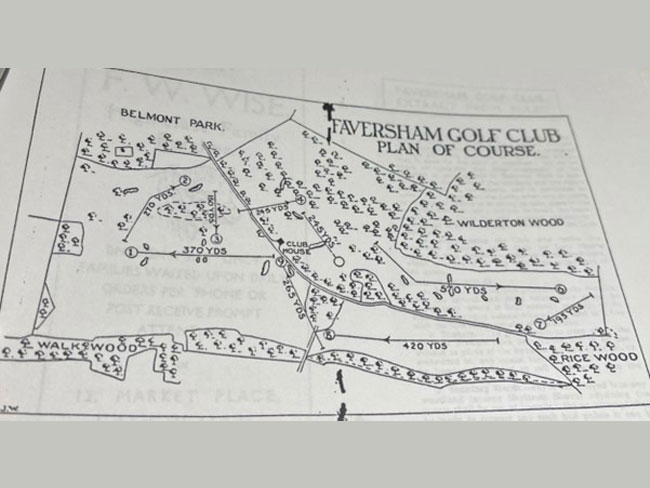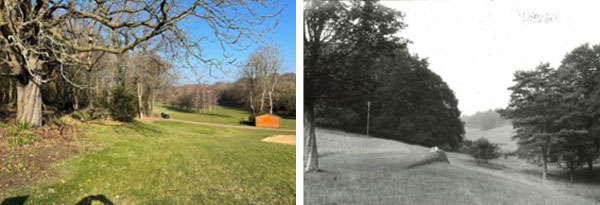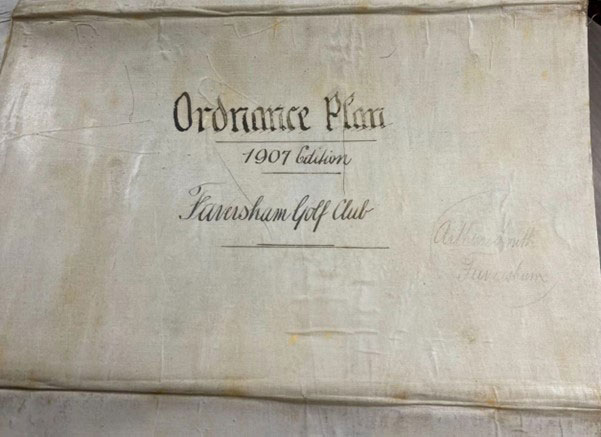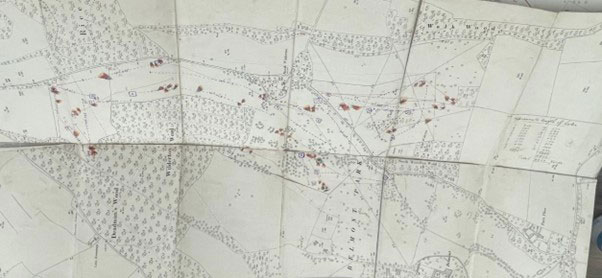The discovery of an architect plan designed by legendary Dr Alister Mackenzie (part 1)
Date published: 3 Oct 2023
Thank you to Faversham GC's Head Greenkeeper Rob Clark for sending this article.
"As many of you might know, I have been doing some extensive research into the history of the course. The main reason for this research is to ultimately discover old design features that we might be able to restore back to their former glory or perhaps give us a specific style of bunkering or greens surrounds etc as intended from the original architect.
After reading through our Club centenary book together with many other sources of information such as past newspaper clippings and club handbooks dating back to 1911, I was able to discover that Faversham Golf Club began life at Belmont in 1910 after moving from Nagden Marshes in Graveney which was where the Club started its life in 1902.
Originally, the course was only 9 holes at Belmont and was laid out by the famous architect and five times British Open winner James Braid. Braid, it seems was a very busy man at this time in his career as it was around the time when he had won his 5th Open championship, therefore, unfortunately when it came to implementing his plan at Faversham, he was unable to attend and sent his apologies. Thereafter, the Club then acquired the services of another famous golfer and architect by the name of John Henry Taylor, who coincidentally was also a five times British Open champion. Taylor approved Braids layout with the addition of 25 grass bunkers.
Picture below shows the original 9-hole layout at Belmont.

So, the Golf Club’s early days had some truly great influences from these two renowned golfers and architects, and we can all see from this map that only 3 holes remain from the original 9. These holes are our current 14th, 15th and 7th. Our current 7th hole, which was the original 6th hole on the old 9, was originally 570 yards, and, so I'm told, was the longest hole in Kent in those days. The tee would have originally sat on top of the hill next to the current 6th green. During my research, I was able to find an old picture of this tee which would have certainly been an incredible tee shot played from such an elevated tee down into the valley.
Below, is a picture of the old tee (left) and picture taken from the same spot today (right). Take note of the horse chestnut tree which sat behind the old tee.

Maybe one to restore in the future???
Furthermore, I was able to find out that the course was extended to 18 holes in 1922. This new 18-hole course bears very little resemblance to the course we play on today, due to the course being completely rebuilt and rerouted around 1929.
I also came across an old architect's ordnance plan of the original 18-hole course built in 1922 with proposals for a new 18-hole course marked out with bunkers, greenshapes and mounding. From this plan, I was able to see that these proposals were implemented with the exception of 5 holes that we play today.
So, who was the architect? In the Club’s 1983 handbook, which I am told was written from old Club minutes by Andrew Costelloe, he mentions that in April 1925 the club made an approach to Dr Alister Mackenzie of Leeds. Alister MacKenzie is probably regarded as the very best course architect of any era and even today has three golf courses ranked top ten in the world with Augusta National, Cypress Point and Royal Melbourne! I am sure from that list of courses you will all realise that he was a pretty damn good course architect! Anyway, this got me thinking, was this the architect plan we had recently found of the work of Alister Mackenzie back in 1925?
Well, I can now tell you all that Faversham is now going to need to rewrite the history books because we have now proved that this plan was in fact designed by none other than Dr Alister MacKenzie!!!
After much research, I was able to come across a plan which Alister MacKenzie designed for Willingdon Golf Club in Eastbourne. After studying the plan, I was able to see that the design characteristics were the same as our plan with identical shading etc, but the main giveaway was the handwriting which is without question identical.
Below is both the writing from the Willingdon golf club plan signed by Mackenzie (left) and the Faversham Golf Club plan (right).

As you can see, the handwriting is undoubtedly that of the famous architect. However, we are now waiting for verification from the Mackenzie Society to enable us to publicise our findings to the wider public.
This discovery now means that you can all proudly say that your club with the exception of 5 holes was laid out by the same architect who designed Augusta! I'm sure you will all be watching the Masters with a little more interest next week!!
So where does this leave us now? We are currently discussing where we go from here with this plan but, I'm sure you would all agree that a restoration of the course back to how Dr Mackenzie intended would be sensible and exciting for the future of the course. Obviously, we would need to ensure that all course changes going forward cater for the modern game and with good advice from a modern course architect we would surely be looking to implement a plan which restores many of the original design features, philosophies and characteristics which Mackenzie is renowned for.
Below are 13 principles of Golf course Architecture which Alister Mackenzie famously wrote in his book in 1920. These Principles are still to this day used by many of the modern architects as a checklist for a well-designed
- The course, where possible should be arranged in two loops of 9
- There should be a large proportion of good two shot holes, two or three drive and pitch holes, and at least four one shot holes
- There should be little walking between the green and tees, and the course should be arranged so that in the first instance there is a slight walk forwards from the green to the next tee; then the holes are sufficiently elastic to be lengthened in the future if necessary
- The greens and fairways should be sufficiently undulating, but there should be no hill climbing.
- Every hole should have a different character
- There should be minimum of blindness for the approach shots
- The course should have beautiful surroundings and all the artificial features should have so natural an appearance that a stranger is unable to distinguish them from nature itself.
- There should be a sufficient number of heroic carries from the tee, but the weaker player from the loss of a stroke or portion of a stroke shall always have an alternative route open to them.
- There should be infinite variety in strokes required to play the various holes-viz, interesting brassy shots, iron shots, pitch and run-up shots.
- There should be a complete absence of the annoyance and irritation caused by the necessity of searching for lost balls.
- The course should be so interesting that even the plus man is constantly stimulated to improve his game in attempting shots he has hitherto been unable to play.
- The course should be so arranged that the long handicap player, or even the absolute beginner, should be able to enjoy his round in spite of the fact that he is piling up a big score.
- The course should be equally good during winter and summer, the texture of the greens and fairways should be perfect, and the approaches should have the same consistency as the greens.
I will leave you with a picture of the plan although I'm sure we will have a copy framed so that we can show off our new discovery for you all to see in pride of place in the clubhouse soon.
Front cover

Alister Mackenzie plan for Faversham Golf club

I would like to say a big thank you to everyone who has helped me with my research so far. If anyone has any other useful information in the form of pictures or the history of the course, then please do get in touch with myself of the Office."
Thanks
Rob Clark
Head Greenkeeper



